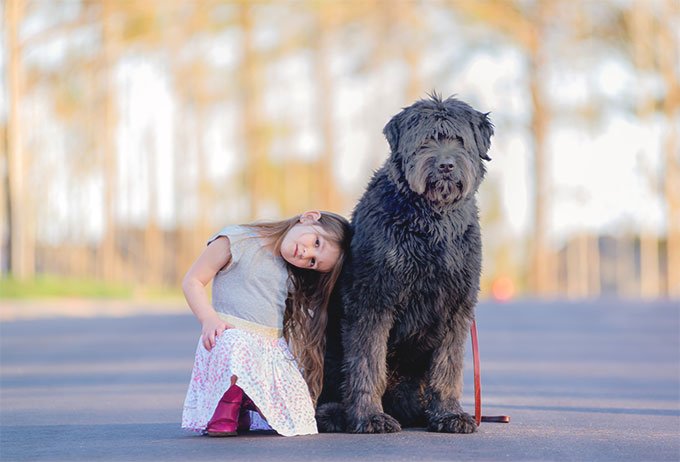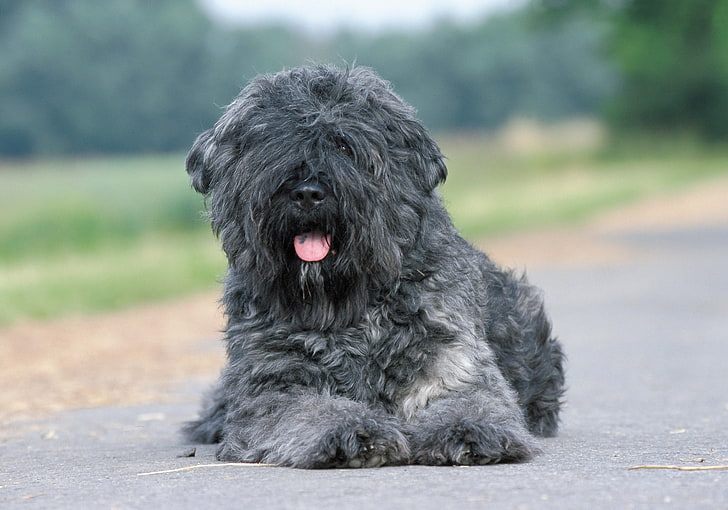Other names: Flanders Cattle Dog & Vlaamse Koehond.
The Bouvier des Flandres is a herding dog breed originating in Flanders, Belgium. They were originally used for general farm work including cattle droving, sheep herding, and cart pulling, and nowadays as guard dogs and police dogs, as well as being kept as pets. The French name of the breed means, literally, “Cow Herder of Flanders”, referring to the Flemish origin of the breed. Other names for the breed are Toucheur de Boeuf (cattle driver), Vlaamse Koehond (Flemish cow dog), and Vuilbaard (dirty beard).
History
The monks at the Ter Duinen monastery were among the earliest known dog breeders in Flanders. The bouviers bred by them are recorded as having been bred from imports such as Irish wolfhounds and Scottish deerhounds with local farm dogs until a breed considered to be the predecessor of the modern Bouvier des Flandres was obtained. This became a working dog able to perform tirelessly, herding and guarding cattle and even pulling cargo carts, thanks to its strength and temperament, and to withstand the local weather conditions due to its thick coat. The breed’s practical use became antiquated after the invention of the automobile when cattle were more practically transported by trucks.

Historically, the ear cropping and tail docking could have been done for practical reasons, avoiding accidental amputations in the course of work, or to indicate the dog was working stock and not a pet subject to taxation.
Up until the early 20th century, the breed was not completely defined, with three variants: Paret, Moerman or Roeselare, and Briard. The conflict between the proponents of these three variants held the breed’s development back. In 1912 and 1913, several local kennel clubs recognized standards for Bouviers; however they usually had different standards for the Roeselare and other variants.
World War I nearly caused the breed to disappear, due to the devastation that came over its region of origin and the fact that the dogs were used for military purposes. Indeed, Nic, a male trained as a trench dog who served during the war and was a perennial winner at dog shows after the war, is considered to be the founder of the early Bouvier des Flandres breed.
A unified Bouvier des Flandres standard was created in 1936 by a joint French-Belgian committee. However, World War II again endangered the breed’s existence. Due to these setbacks, progress was slowed, and it was not until 1965 that the FCI breed standard, as agreed to by several minor kennel clubs, was adopted.
Appearance
The Bouvier is a powerfully built, compact, rough-coated dog of rugged appearance. It gives the impression of size and strength without clumsiness or heaviness. Perhaps its most notable feature is the impressive head which is accentuated by a heavy beard and moustache. Although the practice of cropping both ears and tail are now mostly cosmetic, tails were originally docked to prevent injuries caused by herding and cart-pulling. The practise of cosmetic docking is currently opposed by the American Veterinary Medical Association. In the area of origin (Flanders, Belgium) cropping was made illegal in 2006. The weight of males ranges from 80 to 120 pounds or 36 to 54 kilograms, slightly smaller for females. They are powerfully built, with a thick double coat, which can be fawn, black, grey brindle, or “pepper and salt” in colour. Bouviers are sometimes considered non-shedding, but in fact do lose hair, like all dogs. Most of the hair that they lose is caught within the double coat which results in matting. They require weekly brushing and combing to maintain the coat. In addition to weekly brushing, the coat should be trimmed approximately every 3–5 weeks if it is to be a show dog. Trimming requires to practise to achieve the proper look.
